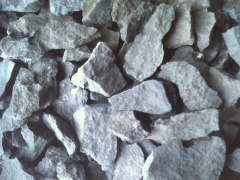Calcium Carbide
| Infobox on Calcium Carbide | |
|---|---|
| Example of Calcium Carbide |  |
| Facts | |
| Origin | |
| Stowage factor (in m3/t) | |
| Humidity / moisture | |
| Ventilation | |
| Risk factors | |
Calcium Carbide
Contents
Description
Calcium carbide is a chemical compound with the chemical formula of CaC2. Its main use industrially is in the production of acetylene and calcium cyanamide.
Calcium carbide is produced industrially in an electric arc furnace from a mixture of lime and coke at approximately 2000°C.
The high temperature required for this reaction is not practically achievable by traditional combustion, so the reaction is performed in an electric arc furnace with graphite electrodes. The carbide product produced generally contains around 80% calcium carbide by weight. The carbide is crushed to produce small lumps that can range from a few mm up to 50 mm. The impurities are concentrated in the finer fractions. The CaC2 content of the product is assayed by measuring the amount of acetylene produced on hydrolysis.
The pure material is colorless, however pieces of technical-grade calcium carbide are grey or brown and consist of only 80-85% of CaC2 (the rest is CaO (calcium oxide), Ca3P2 (calcium phosphide), CaS (calcium sulfide), Ca3N2 (calcium nitride), SiC (silicon carbide), etc.). Because of presence of PH3 (phosphine), NH3 (ammonia), and H2S (hydrogen sulfide), technical-grade calcium carbide has a distinctive smell (garlic like odour) which some find unpleasant.











